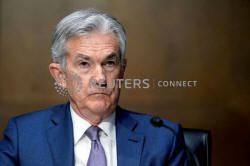Back to the '70s as Fed fuels boom and hopes for no Burns marks
 Send a link to a friend
Send a link to a friend
 [March 17, 2021] By
Howard Schneider [March 17, 2021] By
Howard Schneider
WASHINGTON (Reuters) - Federal Reserve
officials are due to issue new economic projections on Wednesday, with
GDP growth likely to be a blow-out number that sets the stage for an
historic experiment by U.S. central bank policymakers.
Fed Chair Jerome Powell and his colleagues are betting the economy can
take off from the COVID-19 pandemic without generating excessive
inflation, and have vowed to keep interest rates at rock-bottom levels
and a spigot of money flowing for an extended period as they lean into a
potential economic boom in a way not seen since the early 1970s.
In each of the quarterly forecasts released since June, the median GDP
growth projection of Fed officials has been slightly above the median of
private forecasters polled by Reuters. If that holds, it would translate
into expected growth this year of more than 6.2% - the highest annual
rate in 37 years.

GRAPHIC: Fed vs. private 2021 GDP outlook - https://graphics.reuters.com/USA-FED/OUTLOOK/rlgpdbnxzpo/chart.png
But when they issue their policy statement at the end of a two-day
meeting on Wednesday, Fed officials are expected to restate what they've
promised for months now: to keep the central bank's benchmark overnight
interest rate near zero and cash flowing into the economy until
Americans are back to work, trusting that inflation will remain
contained, as it has been for about 30 years.
The economic projections and policy statement are scheduled to be
released at 2 p.m. EDT (1800 GMT). Powell will hold a news conference
shortly after, an event that could prove tricky for the Fed chief.
Markets predict the Fed may be forced to act sooner than expected. Some
policymakers could even hint at that if new projections show more of
them anticipate a rate increase sometime in 2023, rather than a year or
more later.
If a majority see a 2023 hike, "Powell will have his work cut out for
him" explaining how that meshes with a promise to get the economy back
to full employment before reducing the crisis support rolled out when
the pandemic struck, Tim Duy, chief U.S. economist for SGH Macro
Advisors, wrote this week.
Still, investors are already betting on earlier hikes, and some
economists are also raising a red flag along with their forecasts.
Morgan Stanley, among the more bullish in predicting the economy will
have fully escaped its pandemic hole by September, sees the Fed's
approach producing a "hotter but shorter" business cycle that is likely
to prompt it to tighten monetary policy early next year.
The coming cycle would be less like the last three expansions - the one
ended by the pandemic lasted a decade - and more like the period after
World War Two when the intervals between recessions were shorter and
intervening growth stronger.
That epoch ended when then-President Richard Nixon encouraged loose
monetary policy ahead of his 1972 re-election. Arthur Burns, who was the
Fed chief at the time, kept interest rates low as the economy
accelerated, and is often blamed for the ensuing rampant inflation that
dogged the country for a decade.

This time is different, Fed officials argue. Indeed, Powell's legacy may
hinge on whether inflation remains tame as the economy recovers, or
whether prices spike, forcing the central bank to pull back its support
- perhaps with millions of Americans still out of work.
[to top of second column] |

Federal Reserve Chairman Jerome Powell testifies before the Senate
Banking Committee hearing on Capitol Hill in Washington, U.S.,
December 1, 2020. Susan Walsh/Pool via REUTERS/File Photo

Their arguments are well-rehearsed. Inflation and unemployment don't behave as
they used to; lower levels of joblessness can now coexist with low inflation.
The Fed made substantial changes to its policy statement last year encompassing
that thinking, and the guidance issued in December is expected to hold for now.
It pledged to continue its monthly $120 billion of bond purchases until there
was "substantial further progress" towards full employment and 2% inflation.
Moreover, it said interest rates would not increase until those goals were
actually met.
None of those things have happened yet, a point Powell has stressed recently and
will likely again on Wednesday. The economy remains about 9 million jobs short
of its pre-pandemic level; the Fed's preferred measure of inflation, at 1.5%, is
well short of its goal; a new index of slow-moving inflation expectations is
also below target.
GRAPHIC: Substantial further progress for the Fed? Substantial further progress
for the Fed? -
https://graphics.reuters.com/USA-ECONOMY/FEDPROGRESS/
nmovazmdypa/chart.png
'CLEAR-EYED'
Still, it is a pivotal moment as Fed officials issue forecasts incorporating a
bounty of new information.
Since their December projections, more than 100 million COVID-19 vaccines have
been administered in the United States and daily deaths due to the virus have
fallen by two-thirds. Optimism has spiked, and states have begun lifting
restrictions on businesses and reopening schools. Washington also has approved
two new relief packages worth about $2.8 trillion, money now rolling into
household and business bank accounts.
Much has changed since the Burns era, when wages and inflation were tightly
linked, the economy relied more on manufacturing and imported oil, and
unforeseen shocks from an oil embargo were just ahead. [Related graphic:
https://graphics.reuters.com/USA-ECONOMY/STIMULUS/
jbyprdzaqpe/index.html]
The Fed's new approach, moreover, isn't an in-the-moment response to political
pressure, but a policy shift meant to reflect changes in the economy officials
spent years studying.

With an emphasis on job creation and downplaying inflation, the new framework
seemed well suited for the job market crisis spawned by the pandemic. The issue
now is how it meshes with an economy that may recover faster than thought
possible.
Analysts at BlackRock have praised the Fed for being "clear-eyed" about the
economy's problems during the pandemic and in its response to it.
But, wrote Rick Rieder, BlackRock's chief investment officer of global fixed
income, "at some point, the financial stability risks that emanate from an
extremely low policy rate, coupled with the real economy boom that we expect,
could in fact force the Fed's hand."
(Reporting by Howard Schneider; Editing by Dan Burns and Paul Simao)
[© 2021 Thomson Reuters. All rights
reserved.] Copyright 2021 Reuters. All rights reserved. This material may not be published,
broadcast, rewritten or redistributed.
Thompson Reuters is solely responsible for this content. |